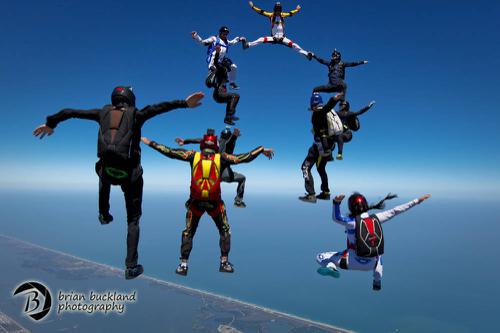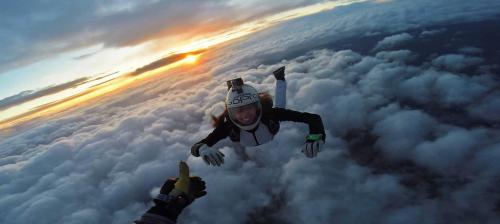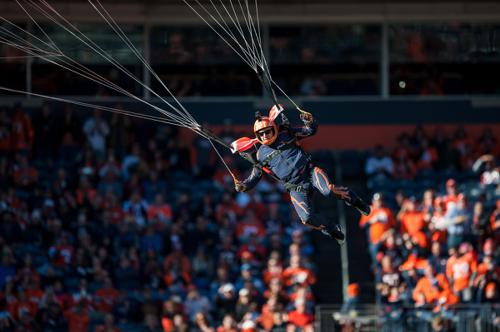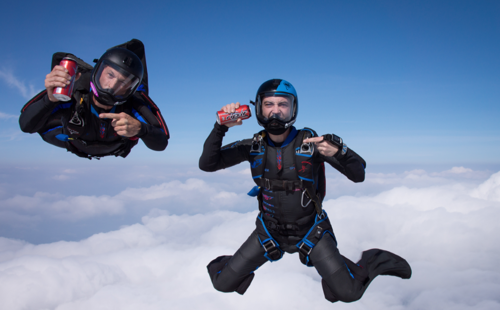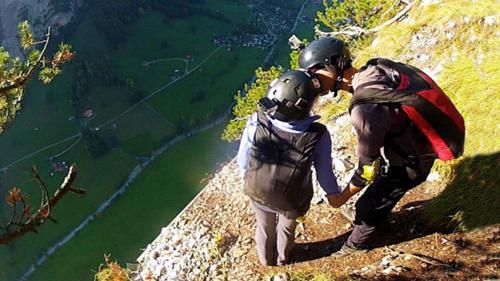At Work With Kenyon Salo and Team Thunderstorm
Kenyon Salo stays pretty busy. When I talk to him, he’s been -- well -- kinda slammed.
“I’ve been doing a lot of skydiving, a little bit of BASE jumping, lots of wingsuiting, building the brand of The Bucket List Life, a dynamic lifestyle design community, doing a lot of keynotes, running a bunch of seminars and trainings...” He pauses for a moment. “And I’m leaving for Cozumel in half an hour to go scuba diving for a week. I should probably pack.”
Kenyon’s also a professional exhibition skydiver. He’s an athlete on not one, but two skydiving demonstration teams. He’s on the Mile-Hi Demonstration Team (the home team for his dropzone, Mile-Hi Skydiving), which does high-profile demo jumps all over the state. He’s also on the official Denver Broncos parachute team: “Team Thunderstorm.” Thunderstorm is unique in the world: no other team in the NFL has their own team of professional parachutists. The team jumps into every single home game.
That would be impressive in and of itself, of course -- but there’s more. The Broncos stadium is as unique as the team that jumps into it. It’s one of the steepest, tightest sports stadiums in the United States. Oh -- and the entire stadium is criss-crossed with metal cables during the high profile games (which is more often than not, since the Denver Broncos are Super Bowl Champions).
“As far as exhibition jumping is concerned, the Bronco’s stadium -- or “Sports Authority Field,” as it’s known officially -- is the diamond. There is a not a harder stadium that’s being jumped right now,” Kenyon explains. “A lot of the older stadiums are really splayed out, where the Bronco’s stadium is really upright. And then there are the cables, of course. This is the most technical demo jump in skydiving.”
To do what Kenyon and his team do on game day, you have to have quite a resume: you have to be a competition-level swooper, you have to be able to speak eloquently to the media, and you have to land a tiny parachute in wicked conditions. Perfectly. Every. Single. Time. That is, to say the least, a difficult job position to fill. Understandably, Team Thunderstorm is small. It has six members, no more, no less: Jimmy Tranter, Stuart Schoenfeld, Justin Thornton, Kenyon Salo and Allison Reay. The number never changes. If one of the jumpers is unavailable on the day of the jump, that jumper is not subbed out.
“The six of us know each other’s flying with great precision,” Kenyon explains, “And we can predict each other, every time. That safety is worth its weight in gold.”
The Air Force used to get into that stadium with 250- or 260-square-foot canopies, navigating the stadium’s unusual topography by sinking their big canopies perilously in and executing a low turn before setting them down. It worked. But then the stadium installed more cables and the pre-game show wanted a higher-speed exhibition. Team Thunderstorm had to envision a better way -- and they did.
“We decided to jump 97-to-120-square-foot Spectres,” Kenyon says. “The reason we jump those is because we have to dive the parachute across the crowd while still keeping a mandated 50-foot distance above them. We do hook turns into the stadium, down the stands, carving right. We pop a toggle at something like 150 feet, then carve across the field, then land.”
“Basically, it’s like parallel parking a Ferrari at 60 miles an hour,” he laughs. “And 99% of the time, we stop between the 20 yard line and the end zone.”
The first time Kenyon made the jump he describes as a moment of “terrifying confidence.” He knew he could do it -- after all, he’d made dozens of successful jumps into the empty stadium before he got the green light to join the team on game day.
“Prior to being accepted as a team member,” Kenyon says, “I’d take advantage of any practice day I could get. I did a lot of practice when there were no actual games on the field. But I was also practicing at the dropzone. I would fly that canopy as much as I could -- work hard on the turn -- and work with Jimmy Tranter, a phenomenal canopy coach for brand new jumpers as well as for Team Thunderstorm, who gave the final okay to DZO and Team Thunderstorm Organizer Frank Casaras, for me to join the team on game days. Jimmy has got 25,000 jumps. When he speaks, everybody listens.”
That constant practice is vital for a jump like this. Even without the dizzyingly steep sides and cable obstacles at the Broncos stadium, stadium jumps are so legendary that they have their own classification in the taxonomy of exhibition jumping. (The classifications are, in order of difficulty: Level 1, Level 2, Level 3 -- and “Stadium.”) This is true because of the super-challenging conditions a stadium creates. The rim of a stadium creates puckering turbulence as the wind hits it from the outside, spilling rough air down into the bowl. These conditions are not for the faint-of-heart.
“When we come over that rim,” Kenyon says, “We have to be prepared for anything and everything. You can easily have 12 mile-an-hour wind at the rim and no wind on the field, so that means within 300 feet of difference in altitude you have got a huge difference in wind speed. And it’s often in different directions.”
“Our small canopies help with that,” he continues, “Because, as we dive through the stadium, speed equals lift -- and the fluid dynamics also make the canopy rigid for smooth flying and landings.
In the Bronco’s stadium, time runs in milliseconds. From the point you come over the rim -- and by that time, you are going very quickly down the field -- you are flying through and underneath a netting of metal cables.
“There’s a single place you can enter,” Kenyon explains. “As soon as you do, you’re moving across the field very quickly, and you’re avoiding those cables. All the cables for the field goal cameras sit at 150 feet. The skycam cables come from the top corners and extend down diagonally; there’s around 350 feet of cable there, stretching down to a point the ground from two directions.” He gives a sideways grin. “It’s very challenging, yet every team member is absolutely prepared mentally and professionally for this demonstration.”
Challenging, yes. Injurious -- not so far. At time of publication, Team Thunderstorm boasted a 100% safety record. Every team jumper has landed on the field on every single jump, with no close calls.
“We have strict parameters that we must follow that are set forth by the USPA (United States Parachute Association) for how demos of this level and caliber must be handled,” Kenyon continues, “Sometimes we have to call it because the cloud ceiling is too low or the winds are beyond our limits. It’s those moments that make this team professional because we always err on the side of caution to make sure safety is paramount.”
“Something Jimmy Trantor taught us, which I hold in the highest regard, is that we must constantly update our mental map on these jumps,” Kenyon articulates. “It’s a running inner monologue that focuses your awareness. ‘I made the turn; ‘the winds have changed;’ ‘I’m going down the crowd now;’ ‘I’m getting a little crosswind over here;’ ‘I’m a little bit over the sideline, I’m bringing it back over the center;’ ‘the field is a little wet;’ update, update, update. We spend the entire jump updating our mental patterns and adjusting. Immediately.”
It’s a zen exercise to keep a high-quality inner monologue going in a stadium situation -- sometimes at night, with pyro; sometimes in wild conditions; always, with the throbbing energy of a massive, excited crowd.
“There’s nothing like jumping out of the plane at 5,000 feet and already hearing the crowd beneath you,” Kenyon exudes. “The crowd sees us exit and just erupts. They are screaming and yelling, and you’re suddenly filled with the knowledge that you’re doing it for them -- the fans that have supported you for seven seasons running; for the camaraderie of the team around you; for the guys playing great football.”
And for the love of skydiving, of course.


